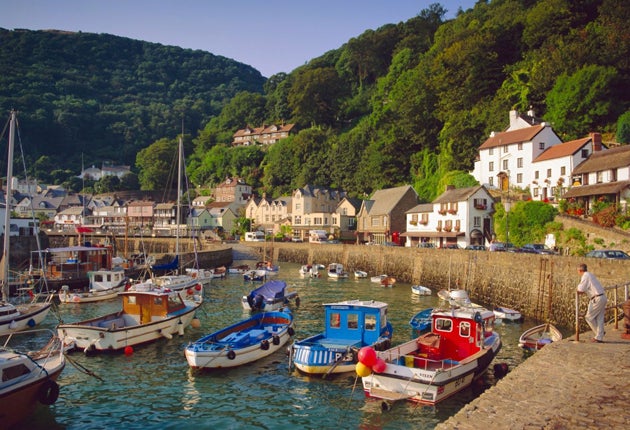A guide to A-road Britain: A39
From Bridgwater to Lynmouth, this road passes through striking landscapes – over the moorland-topped hills of the Quantocks to stunning Exmoor and vertiginous Devon cliffs. David Randall goes west

Your support helps us to tell the story
From reproductive rights to climate change to Big Tech, The Independent is on the ground when the story is developing. Whether it's investigating the financials of Elon Musk's pro-Trump PAC or producing our latest documentary, 'The A Word', which shines a light on the American women fighting for reproductive rights, we know how important it is to parse out the facts from the messaging.
At such a critical moment in US history, we need reporters on the ground. Your donation allows us to keep sending journalists to speak to both sides of the story.
The Independent is trusted by Americans across the entire political spectrum. And unlike many other quality news outlets, we choose not to lock Americans out of our reporting and analysis with paywalls. We believe quality journalism should be available to everyone, paid for by those who can afford it.
Your support makes all the difference.This is one of the longest A-roads in Britain: 204 miles from Bath to Falmouth, and not exactly as the crow flies either.
More like a crab would do it – generally in the right direction but with plenty of sideways shuffles as it crosses Somerset, Devon and Cornwall, mostly inland. But for one glorious 40-mile stretch, it hugs hill and coast and is not so much Britain's Atlantic Coast Highway as what you might call the Bristol Channel Single Carriageway.
Although the A39 spends its early life sauntering across Somerset (touching, but never quite getting to the heart of, Wells, Street and Glastonbury), it is beyond the dreaded M5 that our story begins. Go past Bridgwater and the road soon begins to weave along at the foot of the Quantocks. These are one of the South-west's best-kept secrets: hills with moorland tops (harvestable bilberries in season, and always the chance of seeing red deer at dusk), and – in the folds of the combes – ancient oakwoods and villages. The best of these, like Nether Stowey, are down lanes off the 39, but some parts of them touch it, as does Holford's Plough Inn, where Virginia Woolf spent a less than satisfactory honeymoon.
Some miles on, past the first glimpse of the sea and round steep bends, is St Audries, with its church snuggled below, and The Windmill pub above. Stop here, take a drink, and then take the track to the immediate north of the pub. This soon leads to a disused quarry where peregrines nest and from whose nearby stream wild ponies drink.
Williton and Washford are next, the latter having both the extensive ruins of Cleeve Abbey and a station on the West Somerset Railway. This is Britain's longest preserved line and one of the few to afford the experience of chuffing along the sea and arriving at a beach-side station by steam. The carriageway is fleetingly dual as it runs past Dunster (the views of the castle almost demanding you set up easel and unleash the paints), bypasses Minehead and Selworthy, turns a corner at Allerford (the packhorse bridge off to the right well worth a stop), and so enters Porlock.
Here is one of the most daunting hill climbs in all England, and, in the days of under-powered cars, a challenge too far for many a struggling Singer or Hillman. The road rises 1,300ft (400m) in just under two miles, and has, in places, a gradient of one in four. Its stomach-churning views are best appreciated going down rather than up, although then one has to contend with hairpin bends which are unforgiving to speedsters and coaches with defective brakes.
There is, however, an alternative. Take the lane to Porlock Weir, and you will find the turning for a toll road which reaches the required altitude in somewhat gentler fashion, and does so by cutting through a damp, moss-covered woodland whose streams chuckle or roar according to the volume of recent rainfall. It is a magical, secret place straight out of Lord of the Rings. (Almost as enchanting is a nearby diversion off the A39, down Hookway Hill to the little unclassified road which runs beside Oare Water – trout fry a speciality – past Lorna Doone's wedding venue, to Malmsmead where there is an entertaining ford to cross, and splendid tea rooms.)
Back on the main road is the start of the truly stunning landscapes, with the heights of Exmoor to the east and the Bristol Channel and Wales to the west. There are regular viewpoint car parks, and, especially in September when the heather is purple, they present scenes no camera user can resist. And so it goes on until, past County Gate and into Devon, you go through the village of Countisbury, where the Exmoor Sandpiper Inn is yet another great place to stop and refuel driver and passengers.
Shortly hereafter starts one of the great descents in all Europe. To your left are the ancient rocks of Exmoor pressing down towards the sea, and, to your right, cliffs which range up to 1,000ft high. The sea is blue, the view not so much breath-taking as breath-stopping, and, between you and a long drop to be dashed on the rocks far below is nothing much more than a raised grass verge. This is not the place to meet an overtaking boy racer.
It is, however, when you have gratefully arrived in the bosom of Lynmouth, a suitable place to end this section of the A39. It has many more delights. Entire holidays could be constructed from its pleasures.
Join our commenting forum
Join thought-provoking conversations, follow other Independent readers and see their replies
Comments